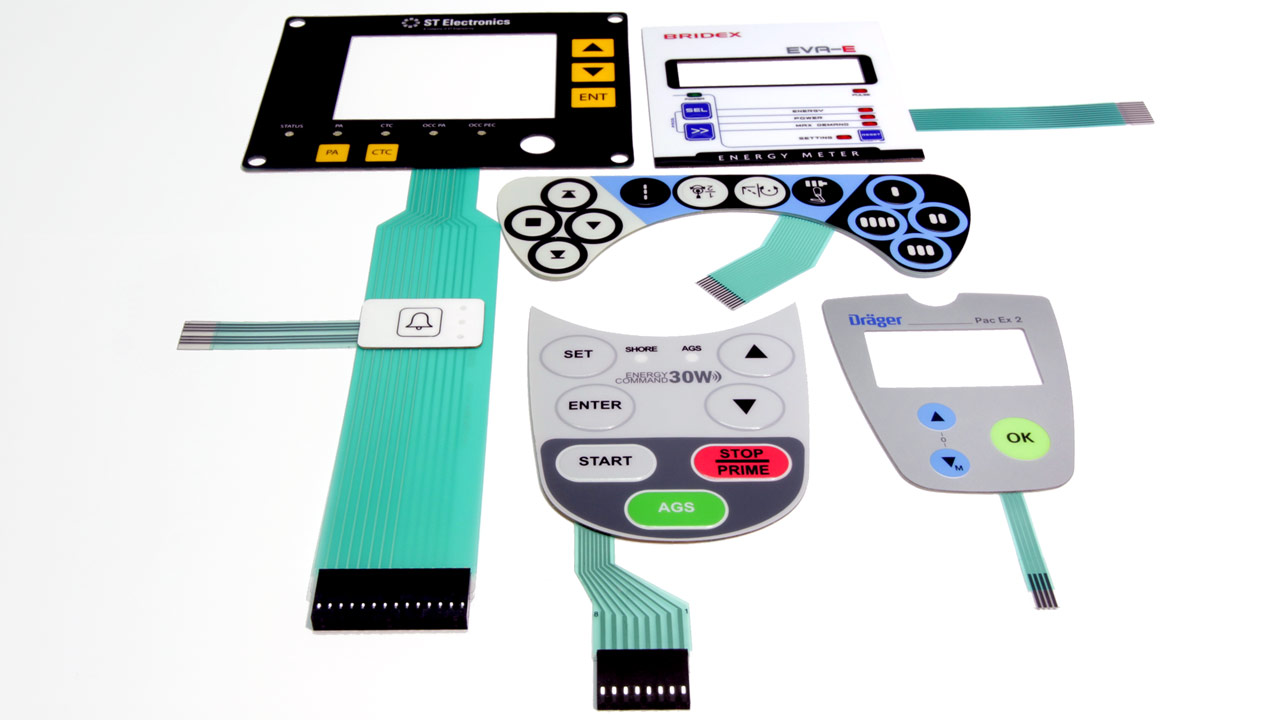Membrane Switches

Membrane switches are printed circuits made by printing conductive ink onto thin plastic sheets. They are typically used as momentary on/off contact switches. Membrane switches are used in many different types of user interfaces, such as in microwave button panels or flexible keyboards.
Membrane switches operate like normal switches; by touching two contact points together, the switch is turned “on”. However, unlike some mechanical switches, membrane switches are purely momentary switches. They only stay “on” when depressed. In membrane switches, metal domes or printed shorting pads are usually used to short printed traces together to activate the switch when pressed.
Features and Benefits of Membrane Switches
- Thin, flat, and unobtrusive
- Membrane switches take up very little design space and can fit in interfaces where space constraint is an issue.
- Hygienic and easy to clean
- There are no gaps or moving parts that could trap contaminants, making them easily to clean and highly appropriate for applications where cleanliness is a concern.
- Easily integrated into larger interfaces
- Membrane switches simply operate as-is, without the need for additional complicated electronics, making them very compatible.
- Durable, robust, and able to withstand harsh conditions
- Membrane switches can easily be designed to be sealed and shielded from moisture, UV, and ESD/EMI & RFI interference.
- Affordable and cost-effective
- With their simplicity of design and ease of production, membrane switches are much cheaper than comparative alternatives such as touch screen interfaces.
- Highly customisable
- Almost everything can be customised in a membrane switch. The graphic overlay can be printed with custom graphics, while the tactile feedback can be adjusted by choosing different metal domes. There is also a wide array of options for backlighting, shielding, and structural backing as well.
Design Options
FPC is able to provide and customise the following design features to suit your unique application:
- Tactile Feedback
- Tactile feedback, achievable through the use of metal domes or embossed polydomes, makes it easy for the user to tell when the switch is activated. Whether you need a low press force with a crisp feel for a medical product or a high press force with an audible "click" sound for industrial use, FPC is able to customise the switch feel to your requirements.
- Built-in Backlighting
- For additional visual feedback, FPC is able to attach surface-mount LEDs to silver-flex, copper-flex and PCB circuits. In addition to point lighting, distributed lighting is also possible. Entire words and icons can be illuminated using light-guides.
- Waterproofing Gaskets
- Through the use of internal gaskets, FPC is able to manufacture water-resistant membrane switches that are able to achieve up to IP65 rating.
- Integrated Shielding
- FPC is able to integrate metal foil or printed conductive EMI/ESD/RFI shielding directly into your membrane switch design.
- Multiple Tail Termination Options
- Whether you need to connect your switch to a LIF/ZIF connector or require a 2.54mm pitch crimped connector, FPC is able to build according to your needs.
Specifications
| Mechanical | |||
| Non-Tactile | Polydome | Metal Dome | |
| Actuation Force | 110 – 450g | 220 – 680g | 240 – 550g |
| Switch Travel | 0.13 – 0.25mm | 0.5 – 0.8mm | 0.35 – 0.60mm |
| Switch Life | >3 million | >1 million | >1 million |
| Emboss Height | =0.5mm | =0.5mm | =0.5mm |
| Emboss Spacing | >4mm | >4mm | >4mm |
| Contact Surface | Customer Specification | Silver, Carbon | Silver, Carbon |
| Flexible Printed Circuit: Copper | Flexible Printed Circuit: Copper | ||
| PCB: Tin/Lead, Carbon, Nickel or Gold-plated | PCB: Tin/Lead, Carbon, Nickel or Gold-plated | ||
| Metal Dome: Nickel or Gold Plated | |||
| Electrical | |
| Contact Configuration | SPST Normally Open |
| Maximum Operating Voltage | 30V DC |
| Maximum Operating Current | 100mA |
| LED Operating Voltage | 1.9 – 4.0 VDC |
| LED Operating Current | 20W – 500W |
| Contact Bounce | <6ms |
| Closed Loop Resistance | <100Ω |
| Insulation Resistance | 100kΩ (with crossover design) |
| 10MΩ (without crossover design) | |
| Environmental | |
| Operating Temperature | -20°C to +70°C (Polydome: 0°C to +50°C) |
| Storage Temperature | -40°C to +80°C (Polydome: -30°C to +60°C) |
| Operating Humidity | 90% RH |
| Storage Humidity | 90%RH |
